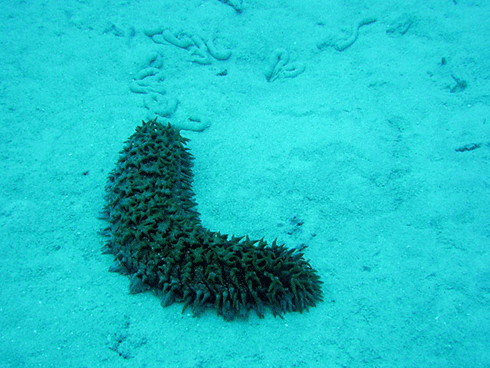
|
Published: 17 March 2014
Reef sea cucumber species under threat globally
Sea cucumbers – known in some parts of the world as trepang or bêche-de-mer – are under greatest risk of extinction in regions with poor economies and high human populations. Species found on Australia’s Great Barrier Reef, however, also appear to be threatened, according to a new study.

|
|
Sea cucumbers serve a useful role in the marine ecosystem as they help recycle nutrients, breaking down detritus and other organic matter, enabling bacteria to continue the degradation process. Credit:
Geir Friestad/ CC BY-NC-ND 2.0
|
The findings are outlined in a paper just published in the Proceedings of the Royal Society B journal.
‘Corals are not the only thing under grave threat on Australia’s Great Barrier Reef. The study highlights that certain sea cucumbers are also at risk due to commercial fishing for export,’ said lead author, Dr Steven Purcell, from Southern Cross University.
Sixteen sea cucumber species were classified as threatened with extinction on the latest IUCN (International Union for Conservation of Nature) Red List. Nine of the 16 species now classified on the IUCN Red List as Vulnerable or Endangered are found on the Great Barrier Reef.
‘Most of those are currently, or have recently been, exploited,’ said Dr Purcell.
‘While I cannot say that the populations on the Great Barrier Reef are at immediate risk of extinction, the species are certainly at grave risk on a broader geographic scale, particularly in low-income developing countries where fishing pressure is high and management insufficient.
‘Within Australia there should be greater investment into independent research to understand population numbers and effects of fishing on our own reefs if we are to safeguard these creatures for ecosystem functions and harvest opportunities for future generations.’
In Australia, threatened sea cucumber species are fished within the Great Barrier Reef Marine Park, the Coral Sea, the Torres Strait, the Northern Territory and the top end of Western Australia.
‘A study published last year showed evidence that high-value sea cucumber species have been serially exploited by commercial fishing on the Great Barrier Reef, attributed in part to unresponsive management and little baseline data on their population sizes,’ Dr Purcell added.
‘That study comes off the back of other recent research indicating that the feeding process of sea cucumbers may provide some help to buffer corals and other reef organisms from the effects of lowering pH of seawater due to elevated carbon dioxide in the atmosphere.’
The study’s authors analysed the relationships between biological and anthropogenic variables and the extinction-risk classifications of sea cucumbers, harvested for Asian luxury seafood markets.
‘High market value related strongly to their risk of extinction. Species in regions with high human population density and poor economies were at greater risk, so conservation is a sociological issue,’ Dr Purcell said.
‘We are calling for greater research on invertebrates, which dominate the earth’s marine biodiversity. We must be watchful of valuable species and support low-income countries to implement trade restrictions of threatened species.’
Credit: Southern Cross University



